Performance Analysis of Loose-Fill Thermal Insulation from Wood Scobs Coated with Liquid Glass, Tung Oil, and Expandable Graphite Mixture
Abstract
1. Introduction
2. Materials and Methods
2.1. Materials
2.2. Preparation of Loose-Fill WS Composites
2.3. Methods
3. Results and Discussion
3.1. Thermal Conductivity and Structural Changes of Control WS and Modified WS Composites
3.2. Moisture Properties of Control WS and Modified WS Composites
4. Conclusions
Author Contributions
Funding
Institutional Review Board Statement
Informed Consent Statement
Data Availability Statement
Conflicts of Interest
References
- Blomqvist, S.; Ödlund, L.; Rohdin, P. Understanding energy efficiency decisions in the building sector—A survey of barriers and drivers in Sweden. Clean. Eng. Technol. 2022, 9, 100527. [Google Scholar] [CrossRef]
- European Commission. A Renovation Wave for Europe—Greening our Buildings, Creating Jobs, Improving Lives 2020. Available online: https://eur-lex.europa.eu/legal-content/EN/TXT/?qid=1603122220757&uri=CELEX:52020DC0662 (accessed on 22 March 2023).
- UNEP. Emissions Gap Report 2019. Available online: https://www.unep.org/resources/emissions-gap-report-2019 (accessed on 22 March 2023).
- AM. Half of the Materials for the Construction of Public Buildings Will Be Wood and Other Organic Materials. Available online: https://am.lrv.lt/lt/naujienos/puse-medziagu-visuomeniniu-pastatu-statybai-sudarys-mediena-ir-kitos-organines-medziagos (accessed on 15 March 2023). (In Lithuanian).
- Zhang, M.; Wang, D.; Li, T.; Jiang, J.; Bai, H.; Wang, S.; Wang, Y.; Dong, W. Multifunctional Flame-Retardant, Thermal Insulation, and Antimicrobial Wood-Based Composites. Biomacromolecules 2023, 24, 957–966. [Google Scholar] [CrossRef] [PubMed]
- Francis, J.K.; Pullan, T.T.; Joseph, M.; Thomas, M.J.; Joseph, K. Investigations on mechanical properties of wood composite for sustainable manufacturing. Mater. Today Proc. 2023, 72, 3111–3115. [Google Scholar] [CrossRef]
- Batool, F.; Islam, K.; Cakiroglu, C.; Shahriar, A. Effectiveness of wood waste sawdust to produce medium- to low-strength concrete materials. J. Build. Eng. 2021, 44, 103237. [Google Scholar] [CrossRef]
- Janesch, J.; Arminger, B.; Gindl-Altmutter, W.; Hansmann, C. Superhydrophobic coatings on wood made of plant oil and natural wax. Prog. Org. Coat. 2020, 148, 105891. [Google Scholar] [CrossRef]
- Bansal, R.; Nair, S.; Pandey, K.K. UV resistant wood coating based on zinc oxide and cerium oxide dispersed linseed oil nano-emulsion. Mater. Today Commun. 2022, 30, 103177. [Google Scholar] [CrossRef]
- Feng, B.; Zhang, S.; Wang, D.; Li, Y.; Zheng, P.; Gao, L.; Huo, D.; Cheng, L.; Wei, S. Study on antibacterial wood coatings with soybean protein isolate nano-silver hydrosol. Prog. Org. Coat. 2022, 165, 106766. [Google Scholar] [CrossRef]
- Li, M.; Hao, X.; Hu, M.; Huang, Y.; Tang, C.; Chen, Y.; Li, L. Synthesis of vanillin-based flame retardant epoxy coating on wood surface. Prog. Org. Coat. 2022, 172, 107161. [Google Scholar] [CrossRef]
- Thougaard, L.; Hayden, P. Wood Preservation Method Using Sodium Silicate and Sodium Bicarbonate. Patent No. WO2014101979A2, 2014, 3 July 2014. [Google Scholar]
- He, Z.; Qian, J.; Qu, L.; Yan, N.; Yi, S. Effects of Tung oil treatment on wood hygroscopicity, dimensional stability and thermostability. Ind. Crops Prod. 2019, 140, 111647. [Google Scholar] [CrossRef]
- Hung, W.-C.; Wu, K.-H.; Lyu, D.-Y.; Cheng, K.-F.; Huang, W.-C. Preparation and characterization of expanded graphite/metal oxides for antimicrobial application. Mater. Sci. Eng. C 2017, 75, 1019–1025. [Google Scholar] [CrossRef]
- Zheng, Z.; Liu, Y.; Zhang, L.; Wang, H. Synergistic effect of expandable graphite and intumescent flame retardants on the flame retardancy and thermal stability of polypropylene. J. Mater. Sci. 2016, 51, 5857–5871. [Google Scholar] [CrossRef]
- EN 12667; Thermal Performance of Building Materials and Products—Determination of Thermal Resistance by Means of Guarded Hot Plate and Heat Flow Meter Methods—Products of High and Medium Thermal Resistance. European Standardization Committee: Brussels, Belgium, 2001.
- ISO 29767; Thermal Insulating Products for Building Applications—Determination of Short-Term Water Absorption by Partial Immersion. International Standardization Organization: Geneva, Switzerland, 2019.
- EN 12086; Thermal Insulating Products for Building Applications—Determination of Water Vapour Transmission Properties. European Standardization Committee: Brussels, Belgium, 2013.
- Shishkin, R.A.; Erkhova, N.A.; Beketov, A.R.; Elagin, A.A. Water-Glass-Based Thermal Paste for High-Temperature Applications. J. Ceram. Sci. Tech. 2014, 5, 199–202. [Google Scholar]
- Qi, C.; Zhang, F.; Mu, J.; Zhang, Y.; Yu, Z. Enhanced mechanical and thermal properties of hollow wood composites filled with phase-change material. J. Clean. Prod. 2020, 256, 120373. [Google Scholar] [CrossRef]
- Chalapud, M.C.; Herdt, M.; Nicolao, E.S.; Ruseckaite, R.A.; Ciannamea, E.M.; Stefani, P.M. Biobased particleboards based on rice husk and soy proteins: Effect of the impregnation with tung oil on the physical and mechanical behaviour. Constr. Build. Mater. 2020, 230, 116996. [Google Scholar] [CrossRef]
- Silva, F.M.; Pinto, R.J.B.; Barros-Timmons, A.M.; Freire, C.S.R. Tung oil-based coatings towards sustainable paper packaging materials. Prog. Org. Coat. 2023, 178, 107476. [Google Scholar] [CrossRef]
- Marrot, L.; Zouari, M.; Schwarzkopf, M.; DeVallance, D.B. Sustainable biocarbon/tung oil coatings with hydrophobic and UV-shielding properties for outdoor wood substrates. Prog. Org. Coat. 2023, 177, 107428. [Google Scholar] [CrossRef]
- Liu, L.; Wang, Z.; Zhu, M. Flame retardant, mechanical and thermal insulating properties of rigid polyurethane foam modified by nano zirconium amino-tris-(methylenephosphonate) and expandable graphite. Polym. Degrad. Stab. 2019, 170, 108997. [Google Scholar] [CrossRef]
- Arous, S.; Koubaa, A.; Bouafif, H.; Bouslimi, B.; Braghiroli, F.L.; Bradai, C. Effect of Pyrolysis Temperature and Wood Species on the Properties of Biochar Pellets. Energies 2021, 14, 6529. [Google Scholar] [CrossRef]
- Yang, H.; Huang, L.; Liu, S.; Sun, K.; Sun, Y. Pyrolysis process and characteristics of products from sawdust briquettes. BioResources 2016, 11, 2438–2456. [Google Scholar] [CrossRef]
- Torres-Carrrasco, M.; Palomo, J.G.; Puertas, F. Sodium silicate solutions from dissolution of glass wastes. Statistical analysis. Mater. Constr. 2014, 64, 1–14. [Google Scholar] [CrossRef]
- Ellerbrock, R.; Stein, M.; Schaller, J. Comparing amorphous silica, short-range-ordered silicates and silicic acid species by FTIR. Sci. Rep. 2022, 12, 11708. [Google Scholar] [CrossRef] [PubMed]
- Bonon, A.J.; Weck, M.; Bonfante, E.A.; Coelho, P.G. Physicochemical characterization of three fiber-reinforced epoxide-based composites for dental applications. Mater. Sci. Eng. C 2016, 69, 905–913. [Google Scholar] [CrossRef] [PubMed]
- Mussa, H.M.; Salih, T.W.M. Thermal conductivity of wood-plastic composites as insulation panels: Theoretical and experimental analysis. Epitoanyag 2021, 73, 54–62. [Google Scholar] [CrossRef]
- Božiková, M.; Kotoulek, P.; Bilčik, M.; Kubik, L.; Hlaváčová, Z.; Hlaváč, P. Thermal properties of wood and wood composites made from wood waste. Int. Agrophys. 2021, 35, 251–256. [Google Scholar] [CrossRef]
- Kol, H.Ş. Thermal and dielectric properties of pine wood in the transverse direction. Bioresources 2009, 4, 1663–1669. [Google Scholar]
- Troppová, E.; Švehlík, M.; Tippner, J.; Wimmer, R. Influence of temperature and moisture content on the thermal conductivity of wood-based fibreboards. Mater. Struct. 2015, 48, 4077–4083. [Google Scholar] [CrossRef]
- Hong, J.; Wang, Z.; Li, L.; Guo, C. Value-added utilization of corncob hydrolysis residues: Preparation of reinforced wood-plastic composite with highly water resistance and decay resistance. Ind. Crops Prod. 2023, 195, 116497. [Google Scholar] [CrossRef]
- Petchwattana, N.; Sanetuntikul, J.; Sriromreun, P.; Narupai, B. Wood Plastic Composites Prepared from Biodegradable Poly(butylene succinate) and Burma Padauk Sawdust (Pterocarpus macrocarpus): Water Absorption Kinetics and Sunlight Exposure Investigations. J. Bionic Eng. 2017, 14, 781–790. [Google Scholar] [CrossRef]
- Humar, M.; Lesar, B. Efficacy of linseed- and tung-oil-treated wood against wood-decay fungi and water uptake. Int. Biodeterior. Biodegrad. 2013, 85, 223–227. [Google Scholar] [CrossRef]
- Tang, C.C.; Li, Y.; Kurnaz, L.B.; Li, J. Development of eco-friendly antifungal coatings by curing natural seed oils on wood. Prog. Org. Coat. 2021, 161, 106512. [Google Scholar] [CrossRef]
- Thirumal, M.; Khastgir, D.; Singha, N.K.; Manjunath, B.S.; Naik, Y.P. Effect of Expandable Graphite on the Properties ofIntumescent Flame-Retardant Polyurethane Foam. J. Appl. Polym. Sci. 2008, 110, 2586–2594. [Google Scholar] [CrossRef]
- Wrześniewska-Tosik, K.; Ryszkowska, J.; Mik, T.; Wesołowska, E.; Kowalewski, T.; Pałczyńska, M.; Sałasińska, K.; Walisiak, D.; Czajka, A. Composites of Semi-Rigid Polyurethane Foams with Keratin Fibers Derived from Poultry Feathers and Flame Retardant Additives. Polymers 2020, 12, 2943. [Google Scholar] [CrossRef] [PubMed]
- Chen, J.; Wang, Y.; Cao, J.; Wang, W. Improved Water Repellency and Dimensional Stability of Wood via Impregnation with an Epoxidized Linseed Oil and Carnauba Wax Complex Emulsion. Forests 2020, 11, 271. [Google Scholar] [CrossRef]
- Huang, J.; Yuan, T.; Ye, X.; Man, L.; Zhou, C.; Hu, Y.; Zhang, C.; Yang, Z. Study on the UV curing behavior of tung oil: Mechanism, curing activity and film-forming property. Ind. Crops Prod. 2018, 112, 61–69. [Google Scholar] [CrossRef]
- Jian, H.; Liang, Y.; Deng, C.; Xu, J.; Liu, Y.; Shi, J.; Wen, M.; Park, H.-J. Research Progress on the Improvement of Flame Retardancy, Hydrophobicity, and Antibacterial Properties of Wood Surfaces. Polymers 2023, 15, 951. [Google Scholar] [CrossRef]
- He, L.; Zhang, T.; Zhao, X.; Zhao, Y.; Xu, K.; He, Z.; Yi, S. Synergistic effect of tung oil and heat treatment on surface characteristics and dimensional stability of wood. Colloids Surf. A Physicochem. Eng. Asp. 2023, 665, 131233. [Google Scholar] [CrossRef]
- Li, C.; Zhang, J.; Han, J.; Yao, B. A numerical solution to the effects of surface roughness on water–coal contact angle. Sci. Rep. 2021, 11, 459. [Google Scholar] [CrossRef]
- Xiao, R.; Yu, Q.; Ye, H.; Shi, Y.; Sheng, Y.; Zhang, M.; Nourani, P.; Ge, S. Visual design of high-density polyethylene into wood plastic composite with multiple desirable features: A promising strategy for plastic waste valorization. J. Build. Eng. 2023, 63, 105445. [Google Scholar] [CrossRef]
- Hammi, M. Surface and Interface Investigations of Matrix−Fillers in Heterogeneous Amorphous Semiconductors. ACS Omega 2021, 6, 34075–34085. [Google Scholar] [CrossRef]
- Rzeczkowski, P.; Krause, B.; Pötschke, P. Characterization of Highly Filled PP/Graphite Composites for Adhesive Joining in Fuel Cell Applications. Polymers 2019, 11, 462. [Google Scholar] [CrossRef]
- Júnior, L.M.; Silva, R.G.; Vieira, R.P.; Maria, R.; Alves, V. Water vapor sorption and permeability of sustainable alginate/collagen/SiO2 composite films. LWT—Food Sci. Technol. 2021, 152, 112261. [Google Scholar] [CrossRef]
- Ilsouk, M.; Raihane, M.; Rhouta, B.; Meri, R.M.; Zicans, J.; Vecstaudža, J.; Lahcini, M. The relationship of structure, thermal and water vapor permeability barrier properties of poly(butylene succinate)/organomodified beidellite clay bionanocomposites prepared by in situ polycondensation. RSC Adv. 2020, 10, 37314. [Google Scholar] [CrossRef] [PubMed]
- García, M.A.; Rodríguez, M.; Castro, C.; Paz, N. Water Vapor Permeability of Chitosan/Zeolite Composite Films as Afected by Biopolymer and Zeolite Microparticle Concentrations. J. Packag. Technol. Res. 2020, 4, 157–169. [Google Scholar] [CrossRef]


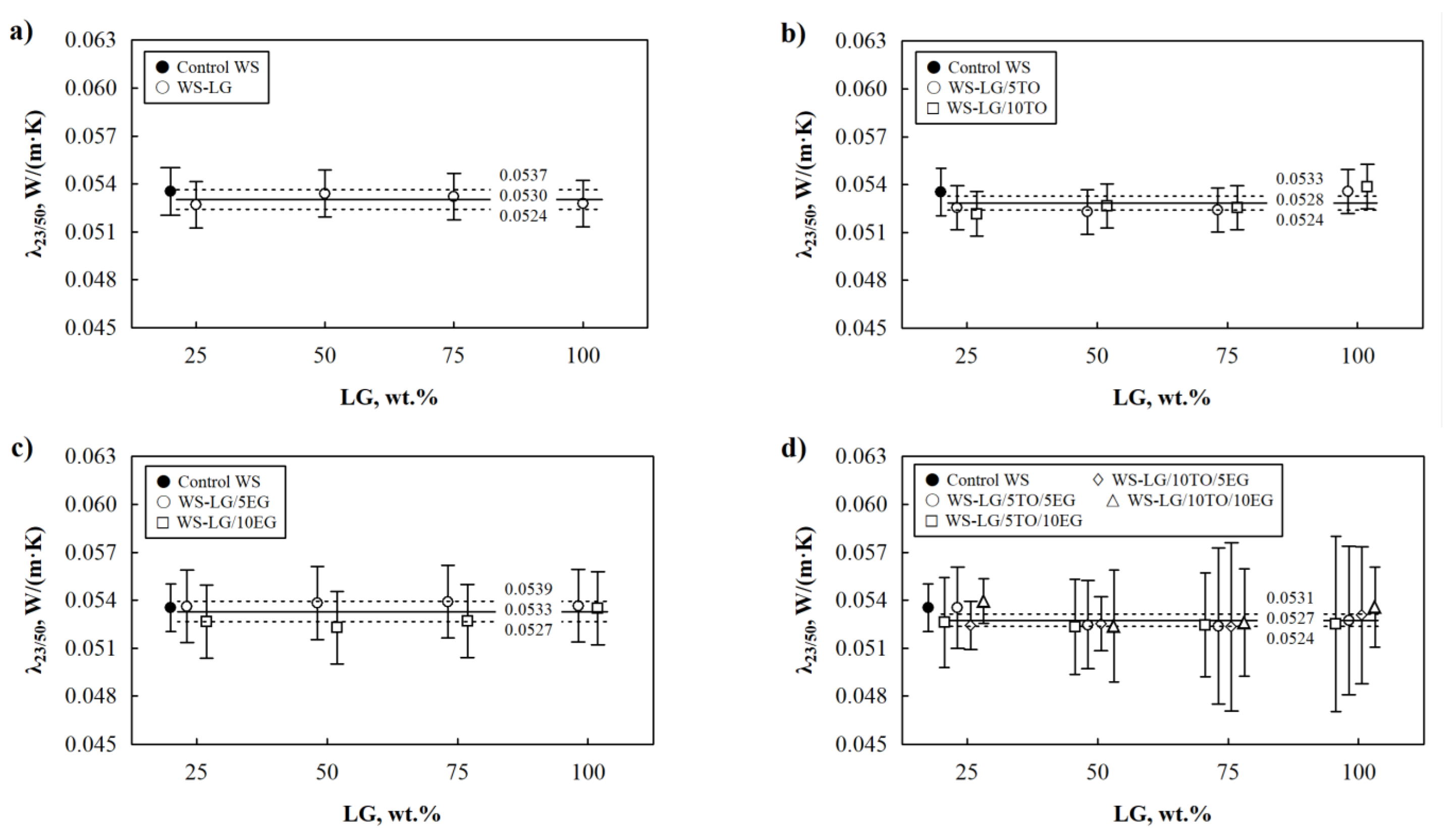

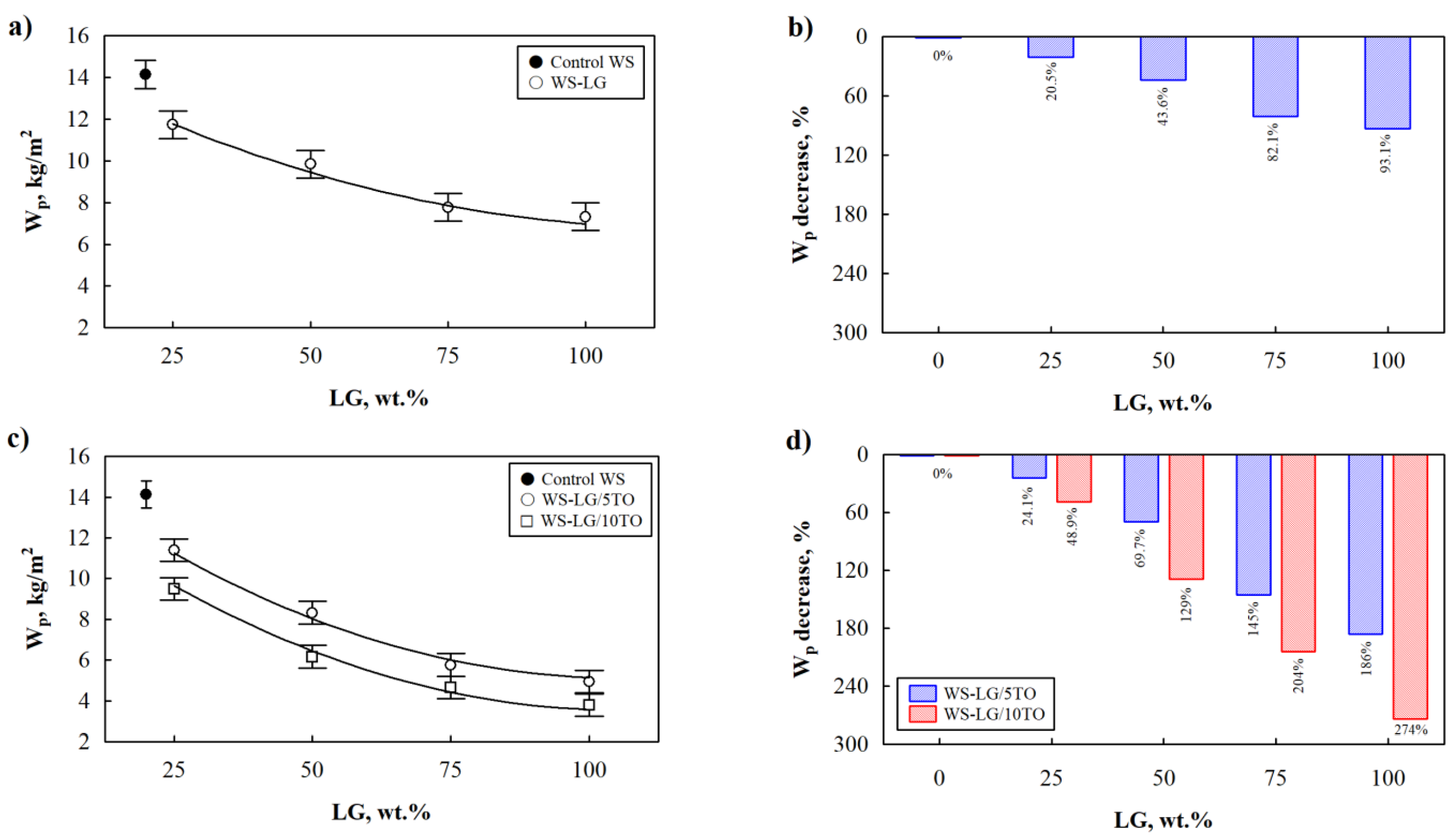
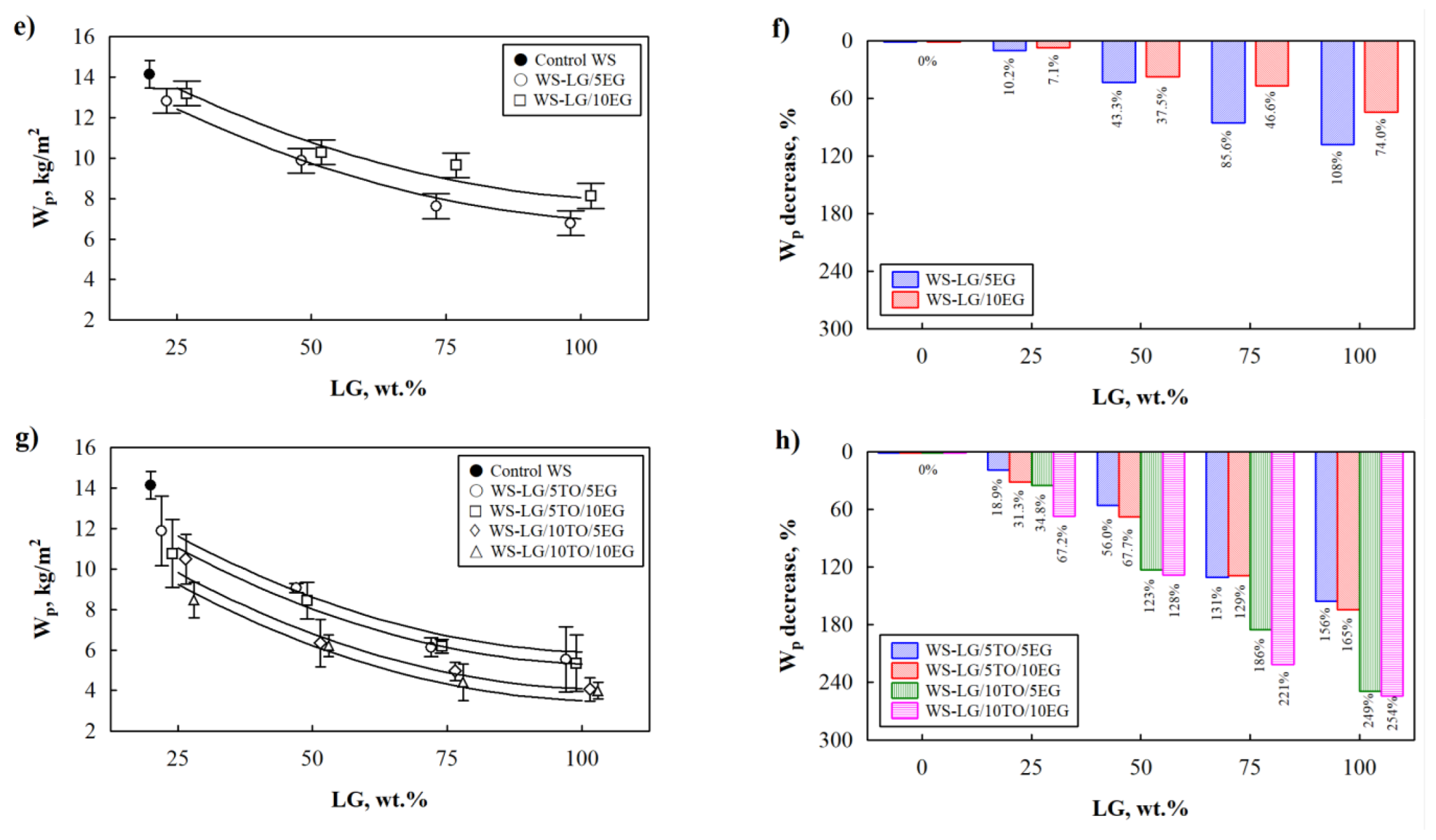
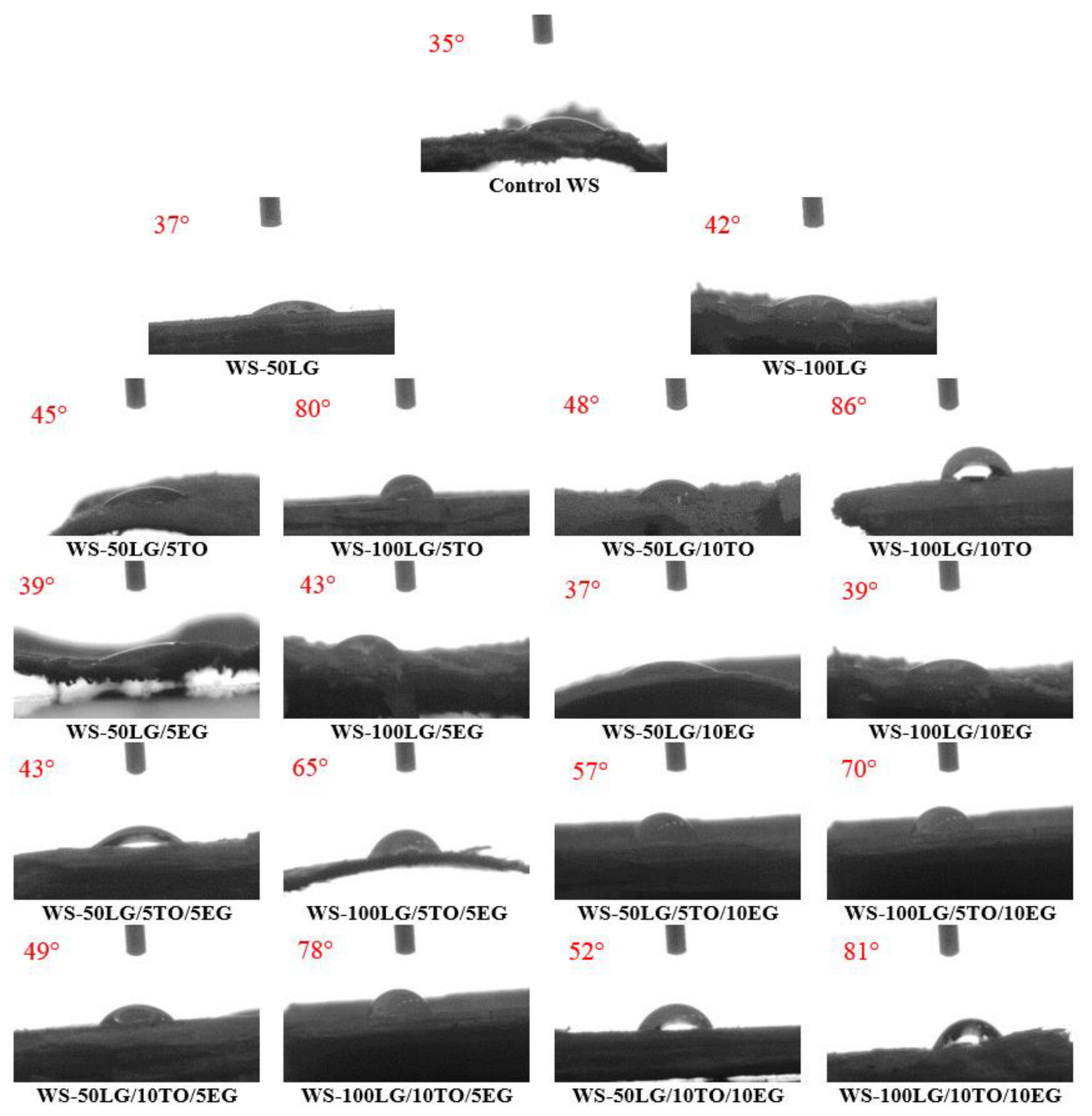
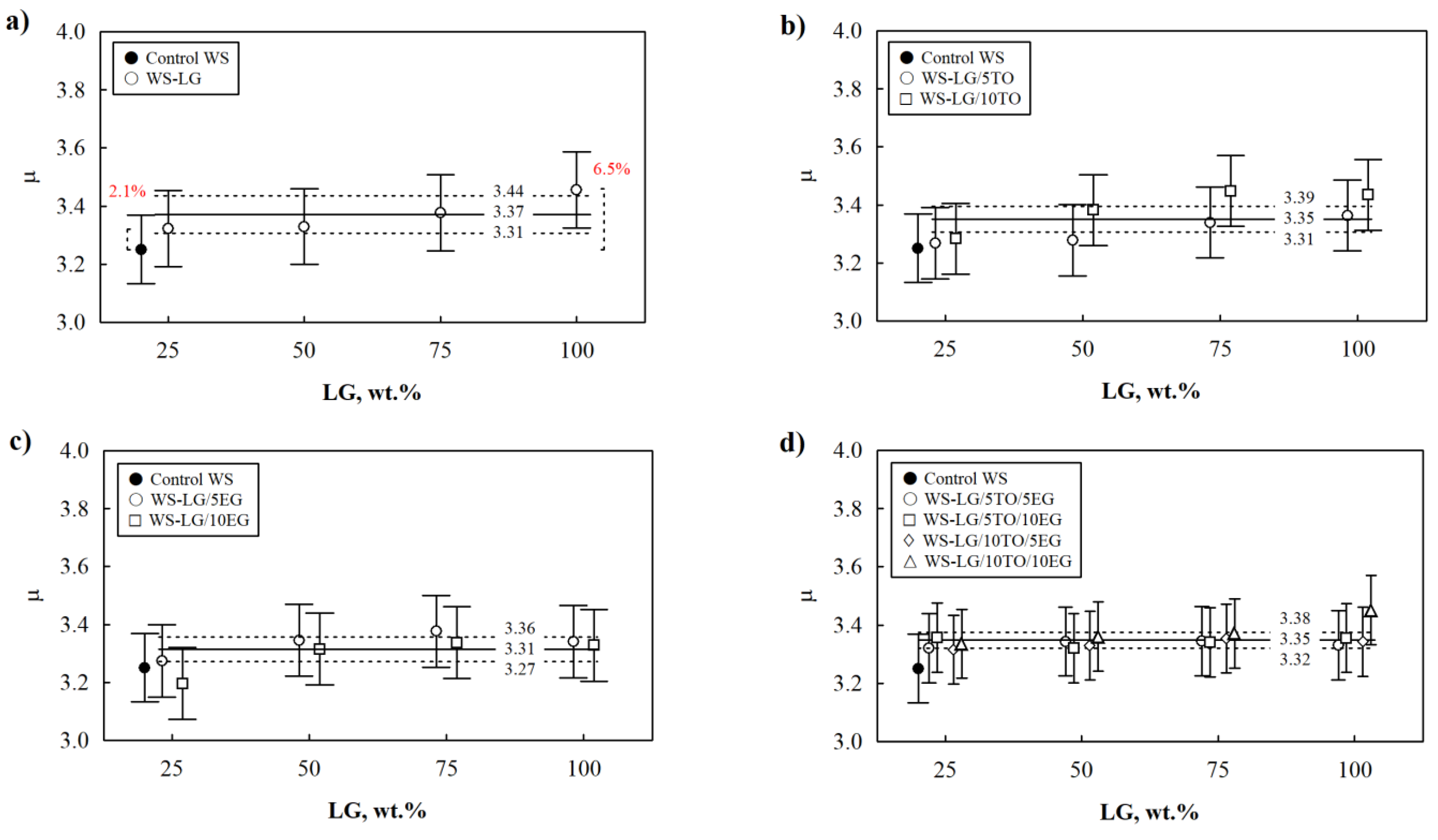
| Sample | Component, % by Weight of WS | |||
|---|---|---|---|---|
| WS | LG | TO | EG | |
| Control WS | 100 | 0 | 0 | 0 |
| LG solution | ||||
| WS-25LG | 100 | 25 | 0 | 0 |
| WS-50LG | 100 | 50 | 0 | 0 |
| WS-75LG | 100 | 75 | 0 | 0 |
| WS-100LG | 100 | 100 | 0 | 0 |
| LG/TO solution | ||||
| WS-25LG/5TO | 100 | 25 | 5 | 0 |
| WS-25LG/10TO | 100 | 25 | 10 | 0 |
| WS-50LG/5TO | 100 | 50 | 5 | 0 |
| WS-50LG/10TO | 100 | 50 | 10 | 0 |
| WS-75LG/5TO | 100 | 75 | 5 | 0 |
| WS-75LG/10TO | 100 | 75 | 10 | 0 |
| WS-100LG/5TO | 100 | 100 | 5 | 0 |
| WS-100LG/10TO | 100 | 100 | 10 | 0 |
| LG/EG solution | ||||
| WS-25LG/5EG | 100 | 25 | 0 | 5 |
| WS-25LG/10EG | 100 | 25 | 0 | 10 |
| WS-50LG/5EG | 100 | 50 | 0 | 5 |
| WS-50LG/10EG | 100 | 50 | 0 | 10 |
| WS-75LG/5EG | 100 | 75 | 0 | 5 |
| WS-75LG/10EG | 100 | 75 | 0 | 10 |
| WS-100LG/5EG | 100 | 100 | 0 | 5 |
| WS-100LG/10EG | 100 | 100 | 0 | 10 |
| LG/TO/EG solution | ||||
| WS-25LG/5TO/5EG | 100 | 25 | 5 | 5 |
| WS-25LG/5TO/10EG | 100 | 25 | 5 | 10 |
| WS-25LG/10TO/5EG | 100 | 25 | 10 | 5 |
| WS-25LG/10TO/10EG | 100 | 25 | 10 | 10 |
| WS-50LG/5TO/5EG | 100 | 50 | 5 | 5 |
| WS-50LG/5TO/10EG | 100 | 50 | 5 | 10 |
| WS-50LG/10TO/5EG | 100 | 50 | 10 | 5 |
| WS-50LG/10TO/10EG | 100 | 50 | 10 | 10 |
| WS-75LG/5TO/5EG | 100 | 75 | 5 | 5 |
| WS-75LG/5TO/10EG | 100 | 75 | 5 | 10 |
| WS-75LG/10TO/5EG | 100 | 75 | 10 | 5 |
| WS-75LG/10TO/10EG | 100 | 75 | 10 | 10 |
| WS-100LG/5TO/5EG | 100 | 100 | 5 | 5 |
| WS-100LG/5TO/10EG | 100 | 100 | 5 | 10 |
| WS-100LG/10TO/5EG | 100 | 100 | 10 | 5 |
| WS-100LG/10TO/10EG | 100 | 100 | 10 | 10 |
| Constant Coefficients in Equations | Standard Deviation Sr | Determination Coeff. R2 | ||||
|---|---|---|---|---|---|---|
| b0 | b1 | b2 | b3 | b4 | ||
| WS-LG: | ||||||
| 0.04640 | −2.125·10−5 | 2.99·10−7 | 0.000125 | 0.954 | ||
| WS-LG/TO: | ||||||
| 0.04699 | −1.654·10−5 | −9.542·10−5 | 2.210·10−7 | 0.000153 | 0.897 | |
| WS-LG/EG: | ||||||
| 0.04554 | −3.779·10−5 | 1.640·10−4 | 4.800·10−7 | 0.000193 | 0.954 | |
| WS-LG/TO/EG: | ||||||
| 0.04549 | −9.702·10−6 | 6.058·10−5 | 1.063·10−4 | 2.117·10−7 | 0.000220 | 0.882 |
| Constant Coefficients in Equations | Sr | R2 | ||||
|---|---|---|---|---|---|---|
| b0 | b1 | b2 | b3 | b4 | ||
| WS-LG: | ||||||
| 14.807 | −0.1336 | 5.787·10−4 | 0.480 | 0.947 | ||
| WS-LG/TO: | ||||||
| 17.208 | −0.1986 | −0.3170 | 9.400·10−4 | 0.472 | 0.971 | |
| WS-LG/EG: | ||||||
| 14.966 | −0.1604 | 0.2073 | 7.040·10−4 | 0.603 | 0.938 | |
| WS-LG/TO/EG: | ||||||
| 18.133 | −0.1866 | −0.3617 | −0.1165 | 8.813·10−4 | 0.550 | 0.955 |
Disclaimer/Publisher’s Note: The statements, opinions and data contained in all publications are solely those of the individual author(s) and contributor(s) and not of MDPI and/or the editor(s). MDPI and/or the editor(s) disclaim responsibility for any injury to people or property resulting from any ideas, methods, instructions or products referred to in the content. |
© 2023 by the authors. Licensee MDPI, Basel, Switzerland. This article is an open access article distributed under the terms and conditions of the Creative Commons Attribution (CC BY) license (https://creativecommons.org/licenses/by/4.0/).
Share and Cite
Augaitis, N.; Šeputytė-Jucikė, J.; Członka, S.; Kremensas, A.; Kairytė, A.; Vėjelis, S.; Balčiūnas, G.; Vaitkus, S. Performance Analysis of Loose-Fill Thermal Insulation from Wood Scobs Coated with Liquid Glass, Tung Oil, and Expandable Graphite Mixture. Materials 2023, 16, 3326. https://doi.org/10.3390/ma16093326
Augaitis N, Šeputytė-Jucikė J, Członka S, Kremensas A, Kairytė A, Vėjelis S, Balčiūnas G, Vaitkus S. Performance Analysis of Loose-Fill Thermal Insulation from Wood Scobs Coated with Liquid Glass, Tung Oil, and Expandable Graphite Mixture. Materials. 2023; 16(9):3326. https://doi.org/10.3390/ma16093326
Chicago/Turabian StyleAugaitis, Nerijus, Jurga Šeputytė-Jucikė, Sylwia Członka, Arūnas Kremensas, Agnė Kairytė, Sigitas Vėjelis, Giedrius Balčiūnas, and Saulius Vaitkus. 2023. "Performance Analysis of Loose-Fill Thermal Insulation from Wood Scobs Coated with Liquid Glass, Tung Oil, and Expandable Graphite Mixture" Materials 16, no. 9: 3326. https://doi.org/10.3390/ma16093326
APA StyleAugaitis, N., Šeputytė-Jucikė, J., Członka, S., Kremensas, A., Kairytė, A., Vėjelis, S., Balčiūnas, G., & Vaitkus, S. (2023). Performance Analysis of Loose-Fill Thermal Insulation from Wood Scobs Coated with Liquid Glass, Tung Oil, and Expandable Graphite Mixture. Materials, 16(9), 3326. https://doi.org/10.3390/ma16093326







